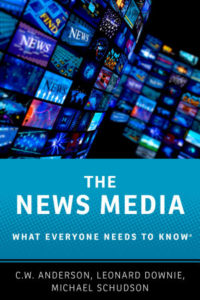Pondering the past, present and future of journalism
Reviewed by Carolyn Schurr Levin, Stony Brook University School of Journalism
A book about the past, present and future of journalism and the news media sounds like a monumental and daunting undertaking. Yet, this is exactly what C. W. Anderson, Leonard Downie Jr. and Michael Schudson have written. In The News Media: What Everyone Needs To Know, released in September 2016, Downie, the former editor of The Washington Post and now a professor at Arizona State University’s Walter Cronkite School of Journalism, Schudson, a professor of journalism at Columbia University, and Anderson, an associate professor at the College of Staten Island, start with the first newspaper in 1605 and end with robots writing news stories in 2016. The authors concede in their first sentence that “[i]t might seem presumptuous to write a book promising readers ‘what everyone needs to know about the news media’ in the year 2016.” And, yet, in under 200 pages, written in a lively question and short answer format, with engaging examples, this book is highly deserving of its lofty title.

The genesis of the book was a comprehensive report commissioned by the Columbia University School of Journalism about the present and future of the journalism profession. That report, “The Reconstruction of American Journalism,” written by Downie and Schudson in 2009, stirred significant discussion and debate in the field. The report led to a request to the authors by the Oxford University Press to add a book about journalism to its popular “What Everyone Needs To Know” series. Oxford touts the series as offering “a balanced and authoritative primer on complex current issues and countries,” written by “leading authorities in their given fields.” The series did not previously include a title on journalism and news media. But, now, fortunately, it does.
The authors divided the work on the book into three parts, Downie said during a recent interview, with Schudson covering the past, Downie covering the present, and Anderson focusing on the future. The collaboration seems to have worked seamlessly. Each section stands on its own and offers singular strengths. Anderson, Downie and Schudson concede up front that they are on stronger ground with the past and present than with the future. “We know a great deal about journalism’s past,” and “there is a great deal of accumulated wisdom about journalism today,” but they admit to be on “far shakier ground when it comes to the future of news.” And yet that acknowledgement does not in the least weaken the impact of the latter section.
The question and answer format of each section is written with students and general readers in mind. It is “an easier read than a textbook,” Downie said, adding that he and his co-authors anticipate that most of their readers will not be experts. They expect general students to find “a great deal of value in the discussion of journalism’s past.” Working reporters and journalism students “may come to this book most interested in” the present. And, the authors ask, “Who doesn’t love a bit of future-of-news prognostication?”
The questions posed in each section range from what may be viewed by sophisticated readers as simplistic, “What is a Pulitzer Prize?” to the provocative, “Why did radio not kill off newspapers?” to the unanswerable, “How will the relationship between journalism and democracy change in the future?” The easy-to-use format allows readers uninterested in one of the questions to skip over it without losing context. Readers can “pick and choose what they want to focus on,” Downie explained.
One of the most interesting questions for college media advisers in the “past” section may be “When was the first interview? And how did interviewing become a standard practice in newsgathering?”. Advisers may be interested to learn that interviews did not become part of journalism until the nineteenth century and then American reporters were the first in the world to make interviewing a chief method for gathering news. “For a long time,” the authors write, “interviewing was regarded as undignified.” Of course, interviewing became standard practice for practically all journalists and journalism students in time. Journalism schools now offer courses specifically on “Interviewing Techniques,” “Interviewing Skills” or “The Art of the Interview.”
Equally interesting is the discussion of how American newspapers came to pride themselves on “objectivity.” There is no single force at work here is the answer the authors proffer. Multiple factors mattered. “College education was rare among reporters in the 1920s, 1930s and 1940s. Newspapers were their own training schools and ‘objectivity’ – sometimes called ‘balance’ or ‘fairness’ – was a useful pedagogy.” But, journalists did not clearly articulate objectivity as an ethical value until after World War I.
There’s much more about the past, including sections on why radio and television did not destroy newspapers. And, the “past” ends with the not so distant past, the creation of Fox News in 1996, and a discussion about whether it ushered in the return of the partisan press.
The “present” begins zealously with “What is news – and what is journalism – today?” Of course, readers will be familiar with the positive ways in which digital technology has altered the news: “It has enabled faster, broader, deeper, and more participatory news reporting that can be distributed digitally to potentially much larger audiences.”
Conversely, digital media “have fragmented audiences and undermined the advertising-based economic models of once dominant newspapers and television and radio networks and stations,” the authors says. In an even-handed way, the book presents both the benefits and costs (lowered journalistic ambitions, imperiled accuracy, among them) of digital technology.
The authors optimistically reassure us that news still plays a significant role in our lives, and they also examine the changing faces of journalism, including for-profit websites such as BuzzFeed, Gawker and TMZ finding their way into present day analysis and billionaires with agendas buying newspapers. News on television, which remains the most popular source of news for Americans, has evolved with digital technology, they say, while noting there is very little news on American radio stations today. Will nonprofit journalism, university-produced journalism or collaboration among news outlets save the day? All of these changing faces of journalism today are explored thoughtfully.
The “future” may be the least satisfying, but also the most fun part of the book. As a college newspaper adviser and journalism educator, I was most anxious to read about “when will newspapers disappear completely?” Part explanatory – what are the new business models, what is entrepreneurial journalism, what is data journalism – and part speculation (“it seems unlikely that the newspaper itself will entirely vanish”), the “future” section concedes in forthright fashion that it’s “hard to be totally certain about anything related to the future of news.”
“What we’ve not done,” Downie said, is make “rash predictions.” Because many of the soothsayers about the future of news have been very wrong, Downie said, the authors preferred to “analyze what the possibilities are.” And, given the far reaching and profound changes taking place in the news media today, that is the most honest thing they could have done. Readers will appreciate it.

Carolyn Schurr Levin is an attorney specializing in Media Law and the First Amendment. She has practiced law for over 20 years, including as the Vice President and General Counsel of Ziff Davis Media and the Vice President and General Counsel of Newsday. She is currently a lecturer and the media law adviser for the Stony Brook University School of Journalism and the director of the journalism program and the faculty adviser for the student newspaper at LIU Post, Long Island University. She earned a J.D. from the University of Chicago Law School, a B.A. from Johns Hopkins University, and a Certificate in Journalism from New York University.
